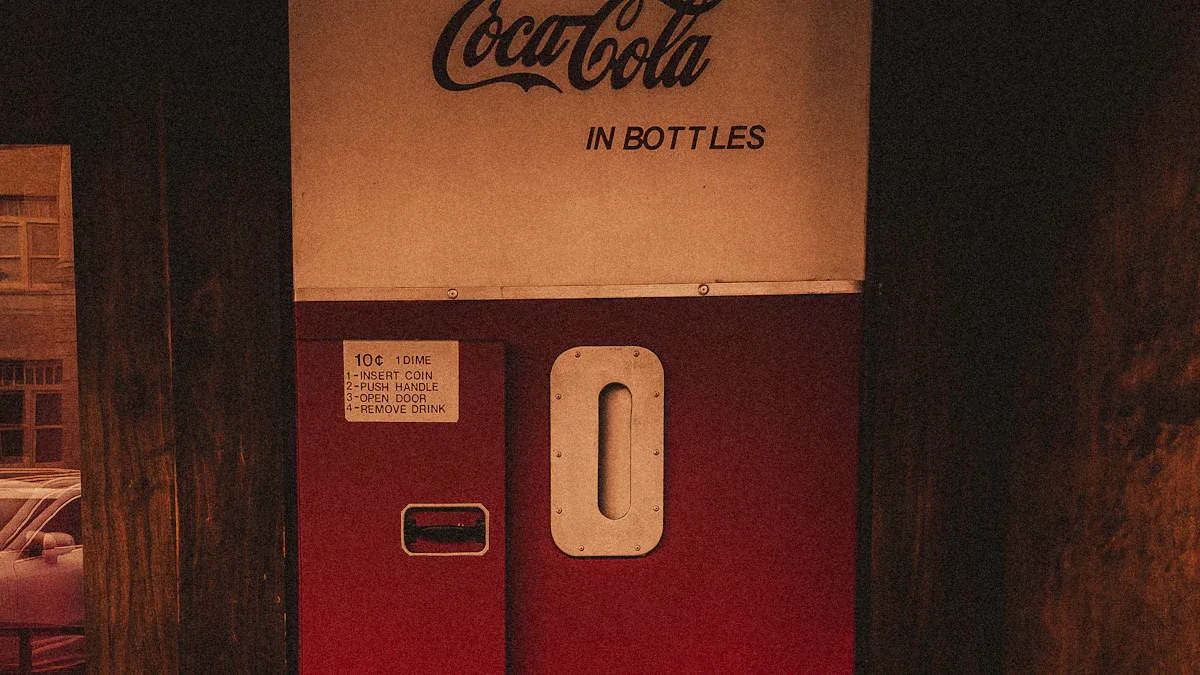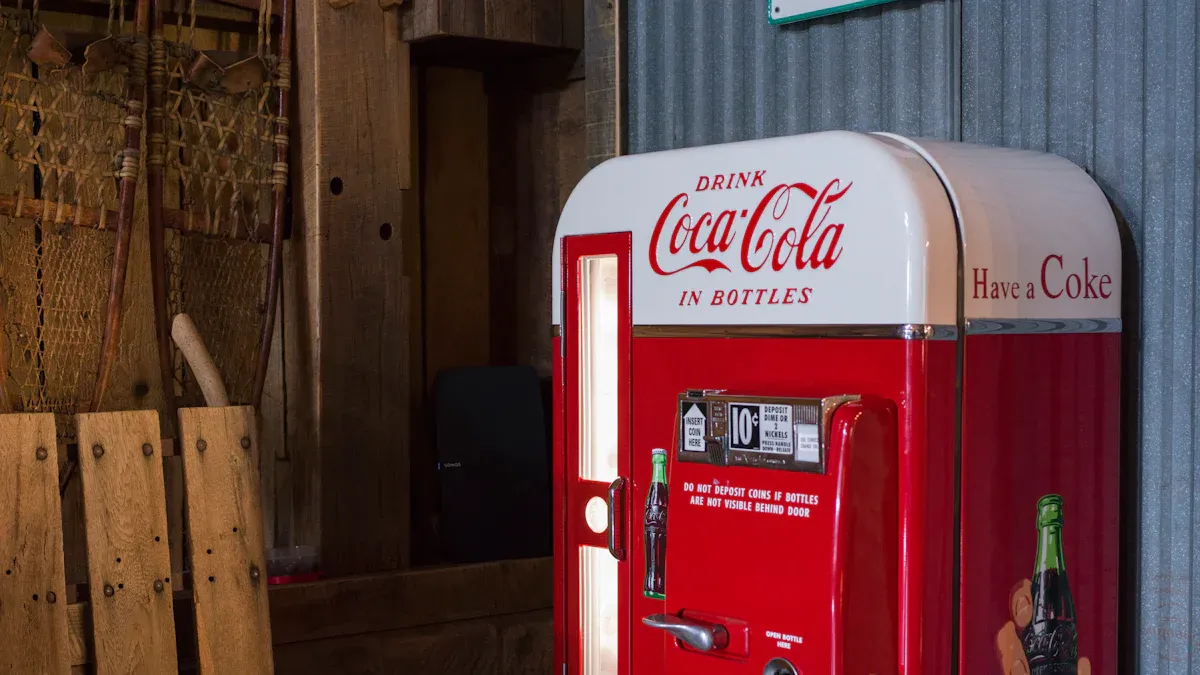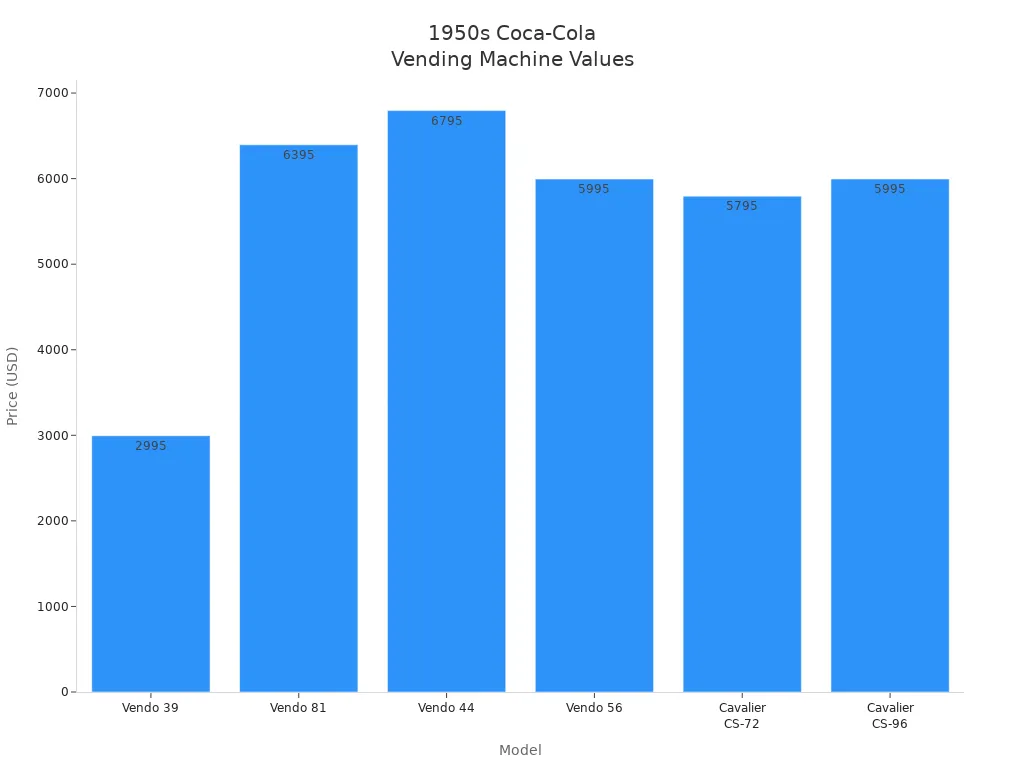The Timeless Appeal of 1950s Coca-Cola Vending Machines: Restoration and Collectibility

You might find yourself drawn to the timeless appeal of a 1950s coca-cola vending machine. The bold colors and shiny chrome details create a retro vibe that feels both familiar and exciting. These machines often remind you of old diners and soda shops.
Many collectors see a coca-cola vending machine as a piece of history that captures the spirit of mid-century America.
Key Takeaways
1950s Coca-Cola vending machines are iconic collectibles that capture the spirit of mid-century America.
Restoring these machines involves careful disassembly, cleaning, and repainting to maintain their original charm.
Collectors value authenticity; using original parts and designs enhances the machine's worth.
The market for vintage vending machines is growing, with restored models fetching prices between $2,500 and $8,000.
Owning a restored Coca-Cola vending machine is not just a nostalgic experience; it can also be a smart investment.
Timeless Appeal and Retro Design

Iconic Features of 1950s Coca-Cola Machines
When you look at a 1950s Coca-Cola vending machine, you notice the timeless appeal right away. The bright red color grabs your attention, and the retro design makes you think of old soda shops. These machines stand out because of their mechanical functionality and ability to dispense different beverages. You get a sense of excitement just by pulling the lever and hearing the bottle drop. The Vendo 44 is a classic example of this mid-century design. It has rounded shoulders and narrow proportions, which remind you of pre-war gas pumps. The white top adds a cool touch, showing off the machine’s ability to keep drinks cold. Even though the Vendo 44 is small, it can hold 44 bottles, with nine already chilled for you to grab quickly.
Here’s a quick look at what makes the Vendo 44 a mid-century classic:
Feature | Description |
|---|---|
Aesthetic Qualities | Rounded shoulders, narrow shape, and a look that feels retro and inviting. |
Functional Features | Lever mechanism for easy use and customer interaction. |
Historical Context | Produced between 1956 and 1959, reflecting mid-century design trends. |
Design Refinement | Efficient design that improves on earlier ideas. |
Color and Material | White top and bright red enamel, with the white top showing coldness. |
Capacity | Holds 44 bottles, with nine chilled for immediate access. |
You also see retro logos and the famous “Drink Coca-Cola In Bottles” lettering. The Ideal Slider Model 55 uses a similar red and white color scheme, making these machines easy to spot and hard to forget.
Nostalgia and Americana
You might feel a wave of nostalgia when you see a Coca-Cola vending machine from the 1950s. These machines are more than just cool designs; they are symbols of Americana. Families collected these machines because they wanted to keep a piece of American history alive. Selling an ice-cold Coca-Cola in a bottle for a nickel was a big part of business back then. The machines helped shape the image of mid-century America, making them a classic part of everyday life. Museums now display these machines to remind you of how important they were. The timeless appeal of these retro icons continues to inspire collectors and fans who want to own a piece of the past.
Restoration Process

Steps to Restore Vintage Machines
Restoring a 1950s Coca-Cola vending machine feels like bringing a piece of history back to life. You start by taking the machine apart, making sure every part is removed carefully. Cleaning comes next. You scrub away years of dust and grime from each piece. Painting the exterior gives the machine its classic look, with bright red and white colors that match the original design. When you reassemble the machine, you pay close attention to how each part fits together. You add bottle ramps using sheet PVC for extra support. Finishing touches matter a lot. You clean the trim, replace old light bulbs, and add stickers that match the original design. Some people like to add LED lights for a modern touch, but you can skip this step if you want to keep the machine authentic. Before you finish, you check everything to make sure the vending machine works perfectly.
Here’s a simple list of the steps you follow:
Disassemble the machine.
Clean all parts.
Paint the exterior and needed components.
Reassemble the machine, placing every part correctly.
Add bottle ramps for support.
Finish with trim cleaning, new bulbs, and stickers.
Optionally add LED lights.
Review and adjust for full functionality.
Restoring a vintage Coca-Cola vending machine takes time and patience. Most experts say you spend over 75 hours on a full restoration. You might feel tired, but seeing the finished machine makes it all worth it.
Common Challenges
You face many challenges when you restore a mid-century vending machine. Some problems are easy to fix, but others need special skills. Dents and rust often show up on the body. You have to fill holes and smooth out rough spots. The cooling system can be tricky. Old compressors lock up, wires fray, and leaks happen. Electrical issues pop up too. Power cords get cut, and wiring can be unsafe. Cosmetic restoration is important. You might install new breaker strips to make the machine look fresh, even if the old ones still work.
Here’s a table showing the most common challenges:
Challenge Type | Description |
|---|---|
Bodywork | You fill and remove dents, sometimes working on large holes. |
Rust and Dents | Rust spots and dents need repair for a smooth finish. |
Cooling System | Old cooling systems need replacement due to locked compressors, frayed wires, and leaks. |
Electrical Issues | Power cords may be cut, and wiring can be damaged, which can be unsafe. |
Cosmetic Restoration | New breaker strips are installed for looks, even if the old ones are still usable. |
Due to the insulation used in antique and classic soda machines, you almost always find rust inside the insulation area. If you don’t take the machine apart completely, you can’t fix this problem. Rust comes from condensation that builds up in the insulation.
You need to pay close attention to every detail. If you skip steps or rush, you might miss hidden problems that affect the machine’s design and function.
Finding Authentic Parts
Finding authentic parts for your restoration project can be tough. You want the machine to look and work like it did in the 1950s. Collectors often search for original pieces, but sometimes you need high-quality reproduction parts. Vintage Restorations is a great place to start. They specialize in vintage restorations and offer reproduction parts that match the original design. You can also check Etsy, where sellers offer both authentic and reproduction Coke machine parts. When you choose parts, make sure they fit the machine’s design and keep its value.
You want to keep the original features, like signage, paint, and mechanical parts. Many restorers use a detailed checklist to make sure every part is checked and restored. Keeping the natural patina and original components helps maintain the machine’s value and historical integrity.
"I personally put decals on it, just like the originals. I don't deviate away from originality because it’s like a classic car. You don’t want to pinstripe a classic car or put decals on it that don’t belong just to make it look pretty. I'm very particular about authenticity because if you do things authentic, then they hold their value."
If you need help, you can reach out to companies that specialize in restoring mid-century vending machines. Here are some trusted names:
Company Name | Services Offered |
|---|---|
Vintage Soda Machine Restoration | Restores vintage soda machines, gas pumps, and other collectibles from the 40s, 50s, and 60s. Offers both restoration services and inventory of unrestored items. |
ERS Company | Skilled craftsmen restore vintage vending machines, including metal and body work. |
Soda City Restorations | Repairs and restores vintage Coke machines from the 1940s to the 1970s, working with customers’ needs and budgets. |
Restoring a 1950s Coca-Cola vending machine lets you enjoy the classic design and history. You get to see how each part fits together and learn what makes these machines special.
Collectibility and Value
Rarity and Market Trends
You might wonder why so many people chase after 1950s vending machines. The answer often comes down to rarity and the timeless appeal of their design. These machines are not just old—they are pieces of history that keep getting harder to find. When you see a classic Coke machine in great shape, you know it stands out from the crowd. The market for these collectibles keeps growing, especially in North America, where retro style and nostalgia drive demand. Themed restaurants and home game rooms love to show off these machines as centerpieces.
If you look at auction prices over the last ten years, you can see how much collectors value these machines. Here’s a quick look at some recent sales:
Model Description | |
|---|---|
Vintage Original 1950's Coke Machine Cavalier C 51 Coca Cola Vending WORKS WELL | $2500 |
VINTAGE 1950's VENDO 81D COCA-COLA DRINK MACHINE ORIGINAL WORKING ORDER-ANTIQUE | $2750 |
Vintage Coca Cola (Coke) 3-D Cardboard Advertising Sign - C. 1925 | $3494 |
Vintage Coca Cola Fish Tail Metal Sign BIG KING SIZE Take Home A Carton 1958 | $2493.1 |
Most fully restored 1950s machines sell for $2,500 to $4,000, but rare models can fetch even more. Some restored machines, like the vendo 44, have sold for up to $8,000. The overall value of vintage beverage dispensers is over $120 million, and experts expect this market to keep growing by about 5% each year until 2028. That means your classic machine could become even more valuable over time.
Popular Models for Collectors
Collectors love certain models because of their design, history, and the retro feeling they bring to any space. You might hear people talk about the vendo 44 as a must-have. This machine is famous for its narrow shape and rounded shoulders, making it a true classic. The vendo 44 is not just about looks—it also has a smart design that keeps drinks cold and ready to go.
Here are some of the most popular models you’ll find in collections:
Vendo 81 – This model is the ultimate vintage machine. Its design is stunning, and it works just like it did in the 1950s.
Vendo 56 – Collectors love this one for its compact size and the way it can chill different drinks.
Cavalier 96-A – This machine is known for being reliable and important in vending history.
You can see how these models compare in the table below:
Model | |
|---|---|
Cavalier 96-A | One of the last round top models, easy to use, and reliable for small businesses. |
CS-72-B | Similar to the 96-A, with a 72-bottle capacity, produced for a short time, making it rare among collectors. |
Vendo 56 | Compact design, versatile for various beverages, highly valued and sought after by collectors. |
Vendo 81 | Iconic design, represents vintage Americana, and is the most popular model among collectors. |
The vendo 44 also stands out. You see it in many top collections because it combines a classic look with smart engineering. Its timeless appeal makes it a favorite for anyone who loves retro style.
Investment Potential
You might ask if owning a 1950s Coke machine is a good investment. The answer is yes, especially if you choose a model with a classic design and restore it well. High-quality restorations add a lot of value. Collectors look for machines that look and work like they did when they left the factory. If you keep the original parts and paint, your machine will be worth even more.
Here’s a chart showing the current prices for some of the most popular models:

Model | Price |
|---|---|
Vendo 39 | $2995 |
Vendo 81 | $6395 |
Vendo 44 | $6795 |
Vendo 56 | $5995 |
Cavalier CS-72 | $5795 |
Cavalier CS-96 | $5995 |
Average Value | $5000-$6000 |
When you invest in a restored vendo 44 or another classic model, you get more than just a cool piece for your home. You also get a collectible that can increase in value. Experts say that rarity, restoration quality, and authenticity all matter. Machines with certification, like the H.J. Nick Brass Tag, are even more valuable. You can also insure your machine at its stated value, which makes it a safer investment.
If you want to make sure your machine is authentic, check the serial number and model number. These numbers tell you when and where the machine was made. Guides like the VMC Vendorlator Coke Machine History and Serial Number Chart help you verify the details.
Collectors love these machines for their timeless appeal, retro design, and classic engineering. When you own a vendo 44 or another favorite model, you hold a piece of history that keeps getting more valuable. The market shows no signs of slowing down, so your investment could pay off for years to come.
You see why 1950s Coca-Cola vending machines never go out of style. These retro icons bring back happy memories with their bright colors and classic designs. Restoring one lets you preserve history and add real value to your collection.
Vintage machines connect people and spark fun moments.
You get to share stories and build community.
If you want to restore a machine, follow these steps:
Disassemble and clean every part.
Remove old paint and rust.
Fill dents, sand, and prime.
Paint with automotive-grade paint.
Polish, re-chrome, and add new decals.
Update the cooling system and wiring.
Reassemble and test.
Ready to start your collection? Look for rare bottles, advertising signs, and original machines. You might find a 1950s model with all original paint and a side mount bottle opener. That’s a true treasure for any collector!
FAQ
How do you tell if your Coca-Cola vending machine is from the 1950s?
Check the serial number and model plate. Most machines have this info inside the door or on the back. You can match these numbers to online guides. If you need help, ask a vintage expert.
What makes a restored machine more valuable?
Original parts and paint boost value. Machines with full documentation and professional restoration fetch higher prices. Here’s a quick look:
Feature | Impact on Value |
|---|---|
Original Parts | High |
Professional Paint | High |
Reproduction Parts | Medium |
Can you use a restored machine for drinks today?
Yes, you can! Many collectors use their machines to chill bottles. Just make sure the cooling system works and the wiring is safe. Always test before loading drinks.
Where can you find authentic replacement parts?
You can search online shops like Etsy or visit specialty restoration companies. Some collectors swap parts at vintage shows. Always check reviews before you buy.
See Also
A Journey Through Antique Vending Machines: Holy Water to Soda
Collecting Unique Vending Machines: A Hobby Worth Exploring
Mountain Dew Vending Machines: A Journey From Classic to Contemporary
The Growth of 24-Hour Vending Cafes: Innovation and Convenience Combined
Vending Machines Through Time: Snacks Evolving Into Smart Devices
